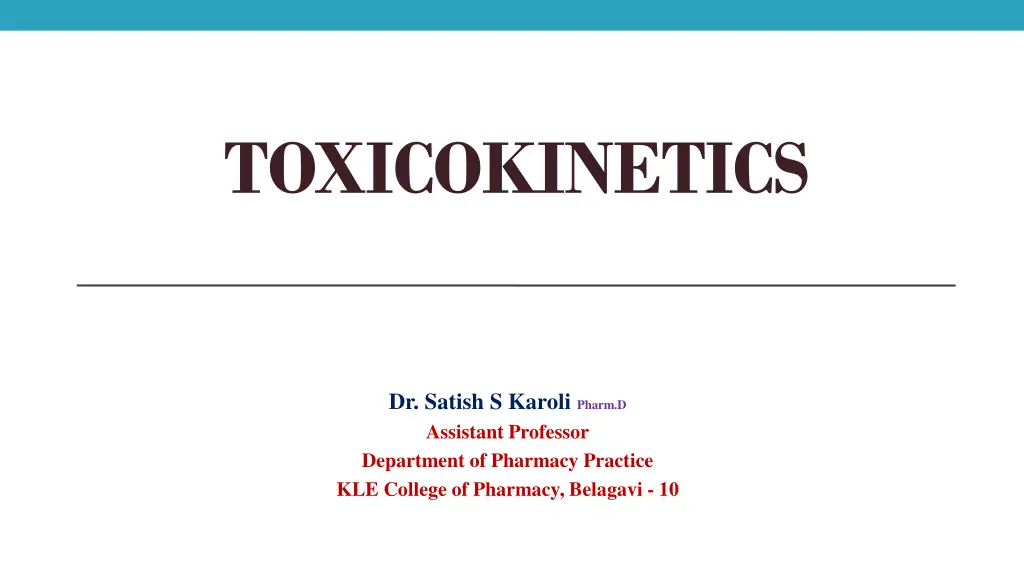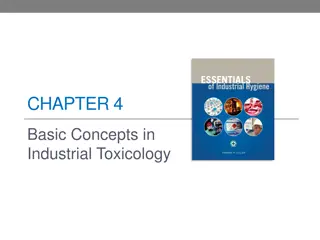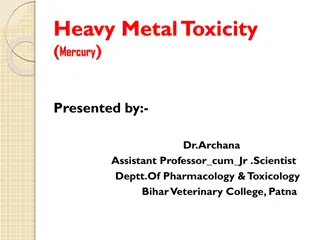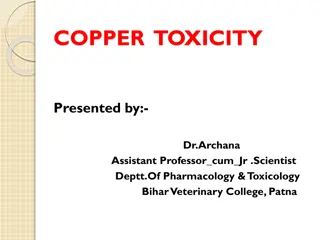
Understanding Toxicokinetics in Pharmacology
Explore toxicokinetics, focusing on absorption, distribution, biotransformation, and excretion of chemicals in the body. Learn about factors influencing absorption through different routes, bioavailability, volume of distribution, and its significance in toxicology. Discover the impact of protein binding and plasma concentration on the rate of distribution of chemicals.
Download Presentation

Please find below an Image/Link to download the presentation.
The content on the website is provided AS IS for your information and personal use only. It may not be sold, licensed, or shared on other websites without obtaining consent from the author. If you encounter any issues during the download, it is possible that the publisher has removed the file from their server.
You are allowed to download the files provided on this website for personal or commercial use, subject to the condition that they are used lawfully. All files are the property of their respective owners.
The content on the website is provided AS IS for your information and personal use only. It may not be sold, licensed, or shared on other websites without obtaining consent from the author.
E N D
Presentation Transcript
TOXICOKINETICS Dr. Satish S Karoli Pharm.D Assistant Professor Department of Pharmacy Practice KLE College of Pharmacy, Belagavi - 10
Toxicokinetics Toxicokinetics deals with absorption, distribution biotransformation (biotransformation) and excretion of chemicals A. Toxicokinetics
i) Absorption: Absorption is the process by which the chemical enters the body. It depends on the route of administration. Oral route the GIT is the most important route of absorption, as most acute poisonings involve ingestions.
Dermal route lipid solubility of a substance is an important factor affecting the degree of absorption through the skin. Inhalational route toxic fumes, particulate and noxious gases may be absorbed through the lungs.
Bioavailability Is the fraction of unchanged drug reaching the systemic circulation following of non-vascular administration. Therefore, a portion of the chemical fails to reach the systemic circulation in original form after oral administration.
ii) Distribution Is defined as the apparent volume into which a substance is distributed. Volume of distribution (Vd) is calculated from the dose taken and the resulting plasma concentration: Vd = dose /plasma concentration.
The importance of volume of distribution in toxicology is : Predicting peak blood concentration of the chemical taken. Calculating the amount of substance in the body to verify the quantity ingested. Deciding whether to apply systemic toxin elimination technique.
Factors determining the rate of distribution of chemicals in the body are: Protein binding Chemicals highly bound to protein have small volume of distribution
Plasma concentration When the volume of distribution of chemicals is small, most of the chemical remains in the plasma.
Physiological barriers Chemicals will not uniformly distributed to the body due to specialized barriers e.g blood brain barrier.
iii) Biotransformation (metabolism) Biotransformation is the biochemical transformation of a chemical. It is a process by which the body transforms a chemical and makes it more water soluble so the chemical can be eliminated more rapidly via the kidney into the urine. Biotransformation can produce metabolites that are pharmacologically active and toxic.
E.g. parathion parathoxon (toxic metabolite). Liver is the major site of biotransformation for many chemicals & other organs that are involved are lungs, kidneys, skin &so on.
Interactions during biotransformation include. There are two phases of biotransformation. 1. Phase I 2. Phase II
1. Phase I the drug is converted into more polar compound e.g oxidation, reduction, &hydrolysis 2. Phase II (conjugation) a drug or its metabolite is conjugated with an endogenous substance e.g glucuronide conjugate Enzyme inhibition- by this the biotransformation of drugs is delayed & is a cause of increased toxicity.
Enzyme induction- by this the biotransformation of drugs is accelerated & is a cause of therapeutic failure. First pass effect is the biotransformation of some chemicals by the liver during the initial pass from the portal circulation after oral administration. Half life (t ) is the time required to reduce the blood concentration of the chemical to half.
IV) Excretion Excretion is the final means of chemical elimination, either as metabolites or unchanged parent chemical. Excretion through the lungs is the major route for gaseous substances; and in the case of non-volatile water soluble drugs, the kidneys are the most important routes of excretion. Additional routes include sweat, saliva, tears, nasal secretions, milk, bile and feces.
Clearance : Elimination of chemicals from the body may be described by the term clearance (CL). It is a quantitative measure of the volume of blood cleared of drug per unit time, usually expressed in milliliter per 4 minute.
Clearance is calculated as follows CL = 0.7 (VD)/ (t1/2) = ml/min Where the VD is expressed in milliliter per kilogram & the half-life is expressed in minutes or hours.
Certain points regarding the Toxicokinetics of toxic agents; Drug absorption after a toxic ingestion may be delayed and prolonged; The half-life and total body clearance are often lengthened; Liver-metabolizing enzymes may become saturated, slowing hepatic elimination;
Chemicals with large volumes of distribution are often highly tissue-bound and measures to enhance their elimination are not effective; Poor perfusion of the liver and kidneys secondary to the toxic effects of the substance may slow clearance.





















